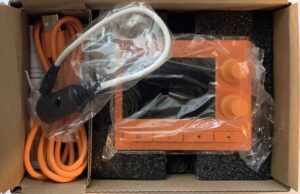Sampling pipe organ with 1010Music’s tangerine renewed my interest in SampleRobot. I figured, what the heck, lets use SampleRobot to capture Yamaha CSP-170 pipe organ voices.
Cabling
The CSP-170 digital piano is located downstairs from my studio. I don’t have a laptop at hand, so, I had to string long MIDI and audio cables between the CSP-170 and the Yamaha AG06 connected to my personal computer (Windows 10). I put a small Rolls mini-mixer in the middle of the audio cables in order to prevent signal loss. Similarly, I put a trusty old MX MIDI Patchbay in the MIDI path, again to prevent signal loss.
SampleRobot’s set-up wizard really streamlines the configuration process. Choose the sample rate (44.1kHz, 16-bit), key interval (every third note), MIDI channel and a few other things. After a few minor glitches, I could see signal in SampleRobot’s peak meter. All seemed operational. Hit record.
Mistake number one — I should have monitored and checked the sound across the full range of keys.
Uh-oh
Well, I couldn’t leave cables strung through the house without causing major grief for my spouse.
Mistake number two — I tore down the cabling before reviewing the samples.
I exported MODX Performances (in Montage library format X7L) and loaded them into the MODX6. That’s when I noticed a buzziness, especially in the lower octaves. Totally unacceptable.
The buzz is not electrical noise, but probably due to the Rolls mini-mixer being slightly overdriven. That’s my guess, anyway. I didn’t feel like stringing cable again, so…
Tangerine to the rescue
Toss the samples captured with SampleRobot. Copy and rename the tangerine sample files (to reflect the key names) and import the tangerine samples into SampleRobot. Export new MODX libraries and test.
Everything sounded good except that I noticed one sample file much shorter than the others. Whoops! Looks like tangerine had failed to collect and write a full eight seconds for one of the lower notes (D#1). Instead of re-sampling the note, I substituted a similar sample from one of the Genos pipe organs. Amazingly, I couldn’t hear a difference playing across the notes! That’s a lucky win in my book.
Although Montage/MODX can probably handle 48kHz samples — I wish Yamaha was specific about this in their documentation — I decided to down-sample to 44.1kHz, 16-bit. SampleRobot handled down-sampling with aplomb.
Gotta mention a couple of fails. I tried auto-looping the tangerine samples with SampleRobot and got too many short and/or lumpy loops. Cross-fade looping was not helping, either. I chose to go ahead without loops as an eight second sampling time is enough for most musical situations (e.g., a note held for two measures at 60BPM, worst case).
Better or just different?
The tangerine samples and Performances sound pretty good on MODX. A/B’ed against my existing pipe organ voices, however, the new pipe organ voices are just OK. There isn’t a “Wow, that is sooooooo much better” sound.
I’m going to leave the samples unlooped rather than invest more time with little return. If I had my socks knocked off, I would feel differently. Those Genos pipe organs are pretty darned good and I’m going to stick with what I’ve got.
Copyright © 2024 Paul J. Drongowski





